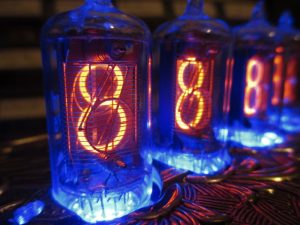
The name Nixie is thought to derive from the Burroughs Corporation’s “NIX I”, which in turn was believed to have stood for “Numeric Indicator eXperimental No.1”.
Each glass tube is filled with a neon-based gas at low pressure and features a wire-mesh anode and layered cathodes shaped like numerals – one separate cathode is needed for every numeral 0 to 9. A distinctive orange glow discharge surrounds each cathode when power is applied to it. By connecting electronic circuitry to several tubes, multi-digit Nixie tube displays were often used for computers, clocks and frequency counters, though were eventually supplanted by more practicable, less costly – yet arguably less charming – displays such as light- emitting diodes (LEDs)
